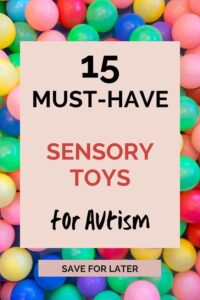
As an occupational therapist, I understand the profound impact that autism play therapy can have on children with autism. Autism play therapy is a powerful tool that helps children with autism develop crucial skills in a fun and engaging manner.
This post aims to provide parents with a comprehensive understanding of autism play therapy and highlight 15 key facts about its benefits and practices.

Hi! My name is Marra and I’m a mama and a pediatric occupational therapist who has years of experience working with children with autism and helping their parents navigate the ups and downs of child development.
I loved being a support person for parents learning about autism, sensory processing, and their child’s individual needs. I would not only provide autism play therapy for the children I worked with who had autism but I would teach parents how to do it with their children at home.
This post is all about autism play therapy and all of the amazing benefits it can have for children with autism and their families. Stay tuned to learn 15 amazing facts about autism play therapy.

What is Autism Play Therapy?
Autism play therapy is a therapeutic approach that uses play to help children express their feelings, improve communication, and develop social skills. It is tailored to the unique needs of children with autism and helps them engage with their environment and peers in meaningful ways.
It involves both structured and unstructured play activities designed to promote emotional, social, and cognitive development. Through autism play therapy,, children can explore their world in a safe, supportive environment, leading to significant improvements in their overall functioning.

15 Facts About Autism Play Therapy
Individualized Approach
Autism play therapy is highly individualized. Therapists tailor activities to each child’s specific strengths, interests, and challenges, ensuring a personalized and effective therapeutic experience.
This customization is crucial because children with autism have diverse needs and abilities.
For instance, a child who loves building blocks might use them to develop fine motor skills and problem-solving abilities, while another who enjoys pretend play might use dolls or action figures to practice social interactions.
Enhances Social Skills
Through guided autism play therapy, children learn essential social skills such as taking turns, sharing, and understanding social cues. These skills are crucial for building and maintaining relationships.
For example, therapists might use games that require collaboration, encouraging children to work together towards a common goal. Over time, these interactions help children understand the importance of cooperation and empathy, which are vital for social success.
Improves Communication
Autism play therapy encourages both verbal and non-verbal communication. Activities are designed to help children express their thoughts and feelings, enhancing their ability to communicate effectively with others.
For instance, a therapist might use picture cards or storytelling to help a non-verbal child convey their emotions and needs. These activities not only improve language skills but also boost confidence in social settings.

Reduces Anxiety
Engaging in autism play therapy can help reduce anxiety and stress in children with autism. The familiar and enjoyable activities create a safe space for children to explore their emotions and experiences.
Therapists often use sensory play, such as playing with sand or water, to provide calming experiences that help children improve their sensory regulation. This reduction in anxiety can lead to better focus and participation in other areas of life, including school and family activities.
Promotes Emotional Regulation
Children learn to identify and manage their emotions through play. Therapists use play activities to teach coping strategies and self-regulation techniques, which are vital for emotional well-being.
For example, a game that involves waiting for a turn can help a child practice patience and impulse control. Additionally, role-playing scenarios can teach children how to handle frustration or disappointment in a healthy way.

Fosters Imagination and Creativity
Autism play therapy stimulates imagination and creativity, allowing children to explore different scenarios and roles. This creative exploration supports cognitive development and problem-solving skills.
Through imaginative play, children can experiment with different outcomes and solutions, enhancing their ability to think critically and adapt to new situations. Activities like dress-up or building imaginary worlds provide a platform for this creative thinking.
Supports Sensory Integration
Many children with autism have sensory processing challenges. Autism play therapy incorporates sensory play activities that help children integrate and respond to sensory information more effectively.
Sensory bins filled with various textures and swinging or bouncing on a therapy ball are examples of activities that can help children become more comfortable with different sensory experiences. These activities can lead to improvements in behavior and attention.
Encourages Peer Interaction
Group autism play therapy sessions provide opportunities for children to interact with their peers. These interactions are guided by the therapist to ensure positive and constructive social experiences.
Group activities such as cooperative games or group storytelling help children practice social skills in a supportive setting. These experiences can be particularly valuable for children who struggle with social interactions in more unstructured environments like school playgrounds.
Builds Confidence and Self-Esteem
Success in play activities boosts children’s confidence and self-esteem. Therapists provide positive reinforcement and celebrate small achievements, fostering a sense of accomplishment.
For instance, completing a puzzle or successfully navigating a social situation during play can make a child feel proud and capable. This increased self-esteem can have a ripple effect, improving a child’s willingness to try new activities and engage with others.
Develops Fine and Gross Motor Skills
Autism play therapy includes activities that improve fine and gross motor skills. From drawing and building to running and jumping, these activities enhance physical coordination and strength.
For example, playing with clay or threading beads can improve fine motor skills, while activities like obstacle courses or ball games develop gross motor skills.
These improvements in motor abilities can enhance a child’s ability to participate in everyday activities and sports.
Facilitates Problem-Solving Skills
Through play, children encounter various challenges and scenarios that require problem-solving. Therapists guide them in developing strategies to overcome obstacles, enhancing their cognitive abilities.
For example, building a tower with blocks requires planning and perseverance, while solving a puzzle involves critical thinking and pattern recognition. These problem-solving skills are essential for academic success and everyday life.

Provides a Safe Environment
Autism play therapy offers a safe and controlled environment where children can explore their emotions and behaviors without fear of judgment. This safety encourages open expression and exploration.
The therapist creates a trusting relationship with the child, allowing them to feel secure and understood. This safe space is particularly important for children with autism, who may feel overwhelmed or misunderstood in other settings.
Involves Parent Participation
Parents are often encouraged to participate in autism play therapy sessions. This involvement helps parents understand their child’s needs better and reinforces therapeutic strategies at home.
For instance, a therapist might demonstrate a play activity that parents can continue at home, ensuring consistency and reinforcement of skills.
Parental involvement also helps build a supportive and understanding family environment, which is crucial for the child’s progress.
Supports Academic Learning
Autism play therapy activities can be aligned with academic goals, helping children develop skills that support their learning. For example, games that involve counting or letter recognition can reinforce educational concepts.
Therapists might use educational toys or activities that blend learning with play, making education more engaging and accessible for children with autism. This integration of play and learning can improve academic performance and motivation.
Enhances Overall Development
Ultimately, autism play therapy promotes holistic development. By addressing emotional, social, cognitive, and physical aspects, it helps children with autism thrive in various areas of their lives.
The comprehensive nature of autism play therapy ensures that children are supported in a well-rounded manner, leading to improvements in overall quality of life and well-being. This holistic approach is essential for fostering long-term growth and development.

How Does Autism Play Therapy Work?
Assessment and Goal Setting
Therapists begin by assessing the child’s current abilities, interests, and challenges. This assessment may involve observations, standardized play based assessments, and discussions with parents.
Based on this assessment, specific goals are set to address the child’s unique needs. These goals might include improving social interactions, enhancing communication skills, or reducing anxiety.
Structured and Unstructured Play
Autism play therapy sessions typically include a mix of structured and unstructured play activities. Structured play involves specific tasks or games designed to achieve therapeutic goals. For example, a therapist might use a board game to teach turn-taking and following rules.
Unstructured play allows the child to explore and engage freely, providing opportunities for self-expression and creativity. oth types of play are important for achieving different therapeutic objectives.
Therapist-Guided Interaction
The therapist guides interactions during play, modeling appropriate behaviors and providing support as needed. This guidance helps children learn new skills and apply them in various contexts.
For example, during a role-playing activity, the therapist might demonstrate how to initiate a conversation or handle a disagreement. This modeling and support are crucial for helping children generalize skills from therapy to real-life situations.
Regular Evaluation
Progress is regularly evaluated to ensure that the therapy is effective. Therapists use various tools and methods to assess progress, including observations, parent reports, and standardized measures.
Activities and goals are adjusted as the child develops, and new needs emerge. This ongoing evaluation ensures that therapy remains relevant and effective for the child’s evolving needs.
Autism play therapy is a valuable tool for supporting children with autism. It offers a joyful and engaging way to help them develop essential skills, manage their emotions, and build meaningful connections with others.
As parents, understanding the benefits and practices of autism play therapy can empower you to support your child’s journey toward growth and development.
By incorporating autism play therapy into their routine, children with autism can experience significant improvements in their social, emotional, and cognitive abilities. If you think autism play therapy might be beneficial for your child, consider consulting with a qualified occupational therapist to explore this therapeutic approach further.
